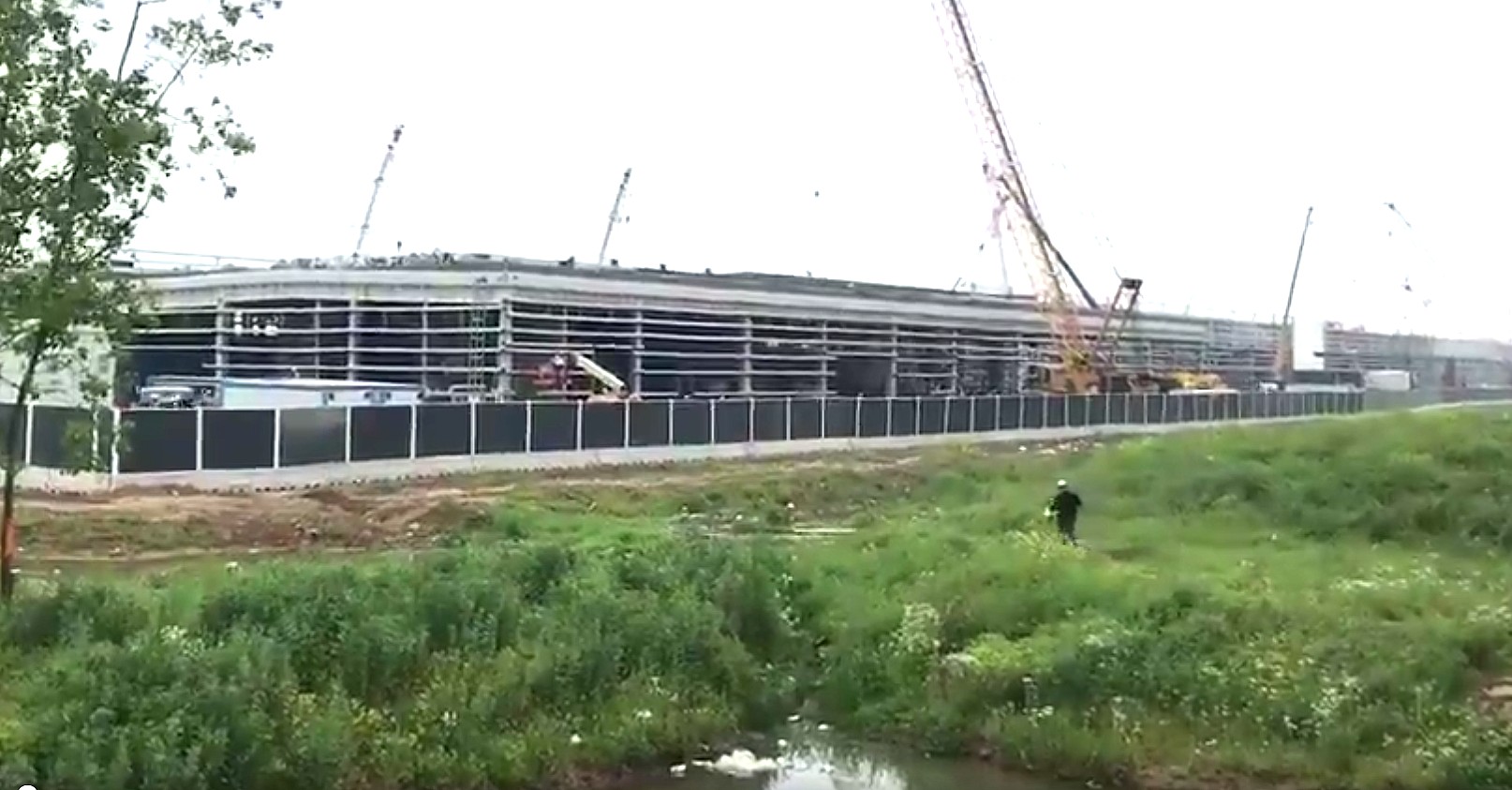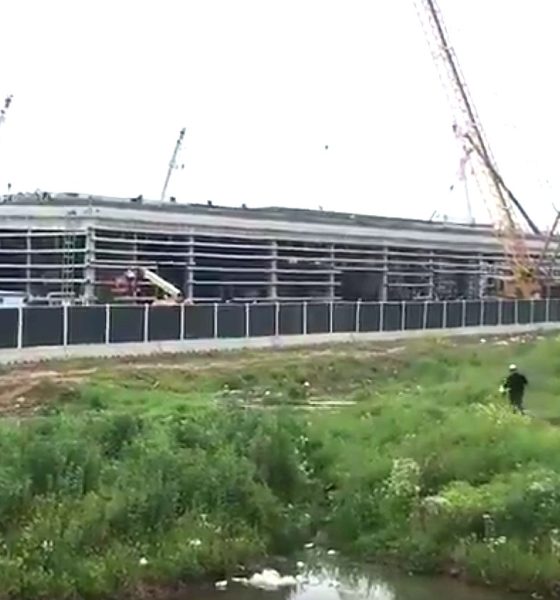

News
Tesla Gigafactory 3 on track to start Model 3 trial production in September
Tesla’s Gigafactory 3 is getting built at an unprecedented pace. From being a bare plot of land in January, Tesla and its construction partner have transformed the Gigafactory 3 site in Shanghai into an industrial area with a massive electric car factory taking shape. The progress of the project has been fast; too fast, in fact, according to an industry expert from China.
Local news agency The Global Times paid a visit to Gigafactory 3 on Sunday, where the publication was able to get some information about the project from one of the workers in the facility. According to the Gigafactory 3 worker, who opted to remain anonymous, the facility is on track to start building electric cars as early as September, notably ahead of Tesla CEO Elon Musk’s estimate.
Musk mentioned during Gigafactory 3’s groundbreaking ceremony that he expects the facility to start producing Model 3s by the end of the year, a timeline that was met with skepticism and mockery from Tesla’s critics. As it turned out, such a target was not only feasible, since China’s workforce, who are working on the site 24/7, is actually capable of beating Musk’s estimates. So quick is Gigafactory 3’s construction that the facility might end up breaking the record in China for fastest factory buildout to date (the record is currently at 17 months).
In a statement to the Times, Feng Shiming, executive director of Menutor Consulting Shanghai, noted that the pace of Gigafactory 3’s buildout is simply too fast, which could cause problems for the company. Feng believes that Tesla will not really start ramping its operations until next year when the suppliers for its locally-produced vehicles are entirely ironed out, though he ultimately notes that a trial production run in September could be feasible.
“The factory’s construction pace is too fast, which is set to leave some problems such as insufficient equipment testing and staff training. The target might be realized at the start of next year, and two or three months after that, its Model 3 can be put into the market on a large scale. Tesla is prepared for not realizing mass production within this year. Trial production in September is likely,” he said.
The current Gigafactory 3 buildout only represents one-third of what the electric car maker plans to construct on the site. The existing buildout has two structures under construction. One is a building that’s about three stories tall with a cement roof, which is already seeing parts of its walls being installed. Another structure is an expansive building that extends over almost half of the overall length of the construction site. This will be Tesla’s general assembly building for the Model 3 and Model Y, according to the construction worker who spoke to the Times during the publication’s visit.
China is the world’s largest electric car market, and Gigafactory 3 is Tesla’s key to competing on even ground against more affordable vehicles from local manufacturers in the country. Affordability appears to be Tesla’s primary strategy for Gigafactory 3, as Elon Musk has previously announced that the Shanghai-based site will be exclusively producing affordable variants of the Model 3 and Model Y, both of which are already Tesla’s most budget-friendly vehicles to date.

News
Tesla FSD fleet is nearing 7 billion total miles, including 2.5 billion city miles
As can be seen on Tesla’s official FSD webpage, vehicles equipped with the system have now navigated over 6.99 billion miles.

Tesla’s Full Self-Driving (Supervised) fleet is closing in on almost 7 billion total miles driven, as per data posted by the company on its official FSD webpage.
These figures hint at the massive scale of data fueling Tesla’s rapid FSD improvements, which have been quite notable as of late.
FSD mileage milestones
As can be seen on Tesla’s official FSD webpage, vehicles equipped with the system have now navigated over 6.99 billion miles. Tesla owner and avid FSD tester Whole Mars Catalog also shared a screenshot indicating that from the nearly 7 billion miles traveled by the FSD fleet, more than 2.5 billion miles were driven inside cities.
City miles are particularly valuable for complex urban scenarios like unprotected turns, pedestrian interactions, and traffic lights. This is also the difference-maker for FSD, as only complex solutions, such as Waymo’s self-driving taxis, operate similarly on inner-city streets. And even then, incidents such as the San Francisco blackouts have proven challenging for sensor-rich vehicles like Waymos.
Tesla’s data edge
Tesla has a number of advantages in the autonomous vehicle sector, one of which is the size of its fleet and the number of vehicles training FSD on real-world roads. Tesla’s nearly 7 billion FSD miles then allow the company to roll out updates that make its vehicles behave like they are being driven by experienced drivers, even if they are operating on their own.
So notable are Tesla’s improvements to FSD that NVIDIA Director of Robotics Jim Fan, after experiencing FSD v14, noted that the system is the first AI that passes what he described as a “Physical Turing Test.”
“Despite knowing exactly how robot learning works, I still find it magical watching the steering wheel turn by itself. First it feels surreal, next it becomes routine. Then, like the smartphone, taking it away actively hurts. This is how humanity gets rewired and glued to god-like technologies,” Fan wrote in a post on X.
News
Tesla starts showing how FSD will change lives in Europe
Local officials tested the system on narrow country roads and were impressed by FSD’s smooth, human-like driving, with some calling the service a game-changer for everyday life in areas that are far from urban centers.

Tesla has launched Europe’s first public shuttle service using Full Self-Driving (Supervised) in the rural Eifelkreis Bitburg-Prüm region of Germany, demonstrating how the technology can restore independence and mobility for people who struggle with limited transport options.
Local officials tested the system on narrow country roads and were impressed by FSD’s smooth, human-like driving, with some calling the service a game-changer for everyday life in areas that are far from urban centers.
Officials see real impact on rural residents
Arzfeld Mayor Johannes Kuhl and District Administrator Andreas Kruppert personally tested the Tesla shuttle service. This allowed them to see just how well FSD navigated winding lanes and rural roads confidently. Kruppert said, “Autonomous driving sounds like science fiction to many, but we simply see here that it works totally well in rural regions too.” Kuhl, for his part, also noted that FSD “feels like a very experienced driver.”
The pilot complements the area’s “Citizen Bus” program, which provides on-demand rides for elderly residents who can no longer drive themselves. Tesla Europe shared a video of a demonstration of the service, highlighting how FSD gives people their freedom back, even in places where public transport is not as prevalent.
What the Ministry for Economic Affairs and Transport says
Rhineland-Palatinate’s Minister Daniela Schmitt supported the project, praising the collaboration that made this “first of its kind in Europe” possible. As per the ministry, the rural rollout for the service shows FSD’s potential beyond major cities, and it delivers tangible benefits like grocery runs, doctor visits, and social connections for isolated residents.
“Reliable and flexible mobility is especially vital in rural areas. With the launch of a shuttle service using self-driving vehicles (FSD supervised) by Tesla in the Eifelkreis Bitburg-Prüm, an innovative pilot project is now getting underway that complements local community bus services. It is the first project of its kind in Europe.
“The result is a real gain for rural mobility: greater accessibility, more flexibility and tangible benefits for everyday life. A strong signal for innovation, cooperation and future-oriented mobility beyond urban centers,” the ministry wrote in a LinkedIn post.
News
Tesla China quietly posts Robotaxi-related job listing
Tesla China is currently seeking a Low Voltage Electrical Engineer to work on circuit board design for the company’s autonomous vehicles.

Tesla has posted a new job listing in Shanghai explicitly tied to its Robotaxi program, fueling speculation that the company is preparing to launch its dedicated autonomous ride-hailing service in China.
As noted in the listing, Tesla China is currently seeking a Low Voltage Electrical Engineer to work on circuit board design for the company’s autonomous vehicles.
Robotaxi-specific role
The listing, which was shared on social media platform X by industry watcher @tslaming, suggested that Tesla China is looking to fill the role urgently. The job listing itself specifically mentions that the person hired for the role will be working on the Low Voltage Hardware team, which would design the circuit boards that would serve as the nervous system of the Robotaxi.
Key tasks for the role, as indicated in the job listing, include collaboration with PCB layout, firmware, mechanical, program management, and validation teams, among other responsibilities. The role is based in Shanghai.
China Robotaxi launch
China represents a massive potential market for robotaxis, with its dense urban centers and supportive policies in select cities. Tesla has limited permission to roll out FSD in the country, though despite this, its vehicles have been hailed as among the best in the market when it comes to autonomous features. So far, at least, it appears that China supports Tesla’s FSD and Robotaxi rollout.
This was hinted at in November, when Tesla brought the Cybercab to the 8th China International Import Expo (CIIE) in Shanghai, marking the first time that the autonomous two-seater was brought to the Asia-Pacific region. The vehicle, despite not having a release date in China, received a significant amount of interest among the event’s attendees.








